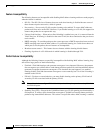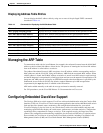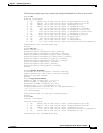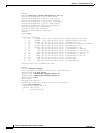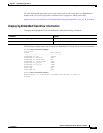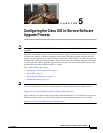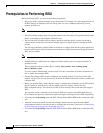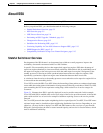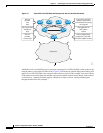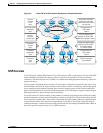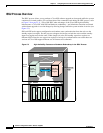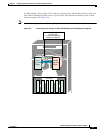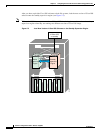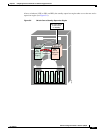
5-2
Software Configuration Guide—Release 15(02)SG
OL-23818-01
Chapter 5 Configuring the Cisco IOS In-Service Software Upgrade Process
Prerequisites to Performing ISSU
Prerequisites to Performing ISSU
Before performing ISSU, you need to meet these prerequisites:
• Image type of the existing and target image must match. For example, you cannot upgrade from an
IP Base image to an Enterprise Services image (and vice versa) without experiencing several
minutes of traffic loss.
Note A similar limitation applies between crypto and non-crypto images.
• The active and the standby supervisor engines must have the same supervisor engine hardware (same
model, same memory, NFL daughter card and so on).
• The new and old Cisco IOS software images must be loaded into the file systems (bootflash or
compact flash) of both the active and the standby supervisor engines before you begin the ISSU
process.
The old image should be available either in bootflash or compact flash and the system should have
been booted from one of these locations because the boot variable should not be changed before the
ISSU process unfolds.
Note auto-boot must be enabled for ISSU to succeed.
• Stateful Switchover (SSO) must be configured and the standby supervisor engine should be in
standby hot state.
These commands indicate whether SSO is enabled: show module, show running-config,
show redundancy state.
If you do not have SSO enabled, see the Stateful Switchover document for further information on
how to enable and configure SSO.
• Nonstop Forwarding (NSF) must be configured and working properly. If you do not have NSF
enabled, see the Cisco Nonstop Forwarding document for further information on how to enable and
configure NSF.
• Before you perform ISSU, ensure that the system is configured for redundancy mode SSO and that
the file system for both the active and the standby supervisor engines contains the new
ISSU-compatible image. The current Cisco IOS version running in the system must also support
ISSU.
You can enter various commands on the Catalyst 4500 series switch or the ISSU application on
Cisco Feature Navigator are to determine supervisor engine versioning and Cisco IOS compatibility.
• If you enter the no ip routing command, ISSU falls back from SSO to RPR mode, resulting in traffic
loss.
• Autoboot is turned on and the current booted image matches the one specified in the BOOT
environmental variable. For details on how to configure and verify these, please refer to "Modifying
the Boot Field and Using the boot Command, page 3-27.
• If you enter the no ip routing command, ISSU falls back from SSO to RPR mode, resulting in traffic
loss.



